Cancerous inhibitor of protein phosphatase 2A enhances chemoresistance of gastric cancer cells to oxaliplatin
Yong-Xun Zhao, Li-Bin Ma, Ze Yang, Fang Wang, Hui-Ying Wang, Jia-Yao Dang
Yong-Xun Zhao, Li-Bin Ma, Ze Yang, The Seventh Department of General Surgery, The First Hospital of Lanzhou University, Lanzhou 730000, Gansu Province, China
Fang Wang, Department of Pathology, The First Hospital of Lanzhou University, Lanzhou 730000, Gansu Province, China
Hui-Ying Wang, Jia-Yao Dang, The First Clinical Medical School, Lanzhou University, Lanzhou 730000, Gansu Province, China
Abstract BACKGROUND Cancerous inhibitor of protein phosphatase 2A (CIP2A) is a newly discovered oncogene. It is an active cell proliferation regulatory factor that inhibits tumor apoptosis in gastric cancer (GC) cells. CIP2A is functionally related to chemoresistance in various types of tumors according to recent studies. The underlying mechanism, however, is unknown. Further, the primary treatment regimen for GC is oxaliplatin-based chemotherapy. Nonetheless, it often fails due to chemoresistance of GC cells to oxaliplatin.AIM The goal of this study was to examine CIP2A expression and its association with oxaliplatin resistance in human GC cells.METHODS Immunohistochemistry was used to examine CIP2A expression in GC tissues and adjacent normal tissues. CIP2A expression in GC cell lines was reduced using small interfering RNA. After confirming the silencing efficiency, 3-(4,5-dimethylthiazol-2-yl)-2,5-diphenyltetrazolium bromide tetrazolium and flow cytometry assays were used to evaluate cell proliferation and apoptosis caused by oxaliplatin treatment. Further, the key genes and protein changes were verified using realtime quantitative reverse transcription PCR and Western blotting, respectively, before and after intervention. For bioinformatics analysis, we used the R software and Bioconductor project. For statistical analysis, we used GraphPad Prism 6.0 and the Statistical Package for the Social Sciences software version 20.0 (IBM, Armonk, United States).RESULTS A high level of CIP2A expression was associated with tumor size, T stage, lymph node metastasis, Tumor Node Metastasis stage, and a poor prognosis. Further, CIP2A expression was higher in GC cells than in normal human gastric epithelial cells. Using small interfering RNA against CIP2A, we discovered that CIP2A knockdown inhibited cell proliferation and significantly increased GC cell sensitivity to oxaliplatin. Moreover, CIP2A knockdown enhanced oxaliplatin-induced apoptosis in GC cells. Hence, high CIP2A levels in GC may be a factor in chemoresistance to oxaliplatin. In human GC cells, CIP2A regulated protein kinase B phosphorylation, and chemical inhibition of the protein kinase B signaling pathway was significantly associated with increased sensitivity to oxaliplatin. Therefore, the protein kinase B signaling pathway was correlated with CIP2Aenhanced chemoresistance of human GC cells to oxaliplatin.CONCLUSION CIP2A expression could be a novel therapeutic strategy for chemoresistance in GC.
Key Words: Cancerous inhibitor of protein phosphatase 2A; Gastric cancer; Oxaliplatin; Chemoresistance; Akt
INTRODUCTION
Gastric cancer (GC) is the most common solid tumor originating from the digestive system and is one of the most severe and fatal malignancies worldwide[1]. GC has a high mortality rate of 75.0% and accounts for 8.8% of all cancer-related deaths[2]. Advanced-stage GC is associated with rapid metastatic growth, relapse, and a poor prognosis with a 5-year survival rate of 30%-50%. Clinically, GC is treatedviasurgical resection and chemotherapy, which is a viable option[3]. The primary treatment for GC is neoadjuvant or adjuvant therapy. Chemoresistance is a major challenge with few benefits. Further, the aggressiveness of GC is attributed in part to intrinsic and extrinsic chemoresistance[4]. As a result, identifying the molecular mechanism of chemoresistance in GC is critical.
S-1 (tegafur, gimeracil, and oteracil potassium capsules) or capecitabine in combination with oxaliplatin is currently used as adjuvant therapy for GC in various East Asian institutions[5,6]. Oxaliplatin is a third-generation platinum analog commonly used to treat GC, resulting in a large amount of platinum-DNA adducts that are poorly identified by the mismatch repair system[7]. Although oxaliplatin initially has a high responsiveness rate, patients eventually develop resistance[8]. Protein kinase B (Akt), also known as protein kinase B, is involved in a variety of critical cellular processes such as cell proliferation and migration, metastasis, and cancer progression[9]. Drug resistance in various types of human cancers is influenced by changes in Akt expression or activity[10-12]. Moreover, trastuzumab resistance is primarily determined by Akt signaling activation in breast cancer[12,13]. The aberrant Akt signaling pathway activation-mediated epithelial-mesenchymal transition is important in the development of doxorubicin resistance in GC cells[14]. Akt signaling has been linked to oxaliplatin resistance in GC cells in several studies[15-17].
Cancerous inhibitor of protein phosphatase 2A (CIP2A) is an oncogene that inhibits c-Myc degradation. CIP2A has been shown to facilitate the proliferation of various cancer cells[18].Moreover, CIP2A is overexpressed in a variety of cancers, including breast, head and neck, prostate, lung, and digestive system cancers[18-20]. In human GC, cancer tissues had higher CIP2A levels than noncancerous tissues. As a result, CIP2A may play an oncogenic role in human GC progression and is correlated with a poor prognosis[21-23]. Recent studies have linked increased CIP2A expression to doxorubicin resistance in human breast and colon cancer cells[24]. Moreover, CIP2A overexpression is associated with cisplatin chemoresistance in human non-small cell lung carcinoma, and Akt phosphorylation may play a role in this process[25]. The effect of CIP2A on oxaliplatin resistance in human GC is unknown.
The current study sought to investigate CIP2A expression in tumor tissue and its relationship to clinicopathological features and prognosis in GC patients. We investigated the expression of CIP2A and its relationship with oxaliplatin resistance in human GC cells as well as the possible mechanisms involved.
MATERIALS AND METHODS
Patients and their clinicopathological characteristics
Between January 2012 and December 2015, 108 paired primary gastric carcinoma tissue and adjacent normal tissue (> 5 cm from the tumor margin and noncancerous tissues determined by the pathologist) specimens were collected from patients undergoing D2 radical resection at the Department of Gastroenterological and Oncological Surgery of the First Hospital of Lanzhou University. Prior to surgery, none of the patients received chemotherapy, radiotherapy, targeted therapy, or immunotherapy. Patients with GC ranged in age from 26-years-old to 78-years-old (mean: 57.3 ± 6.8 years). Table 1 shows the clinicopathological characteristics of patients. The Tumor Node Metastasis stage of the tumor was determined using the 8th edition of the American Joint Committee on Cancer staging manual[26]. All patients were followed up for at least 5 years after surgery. Further, following surgery, all patients received six cycles of S-1 (tegafur, gimeracil, and oteracil potassium capsules) combined with oxaliplatin. To detect the mRNA and protein expression of CIP2A, 18 frozen GC tissue and paired normal tissue specimens were selected. All pathological results were evaluated independently by two specialized pathologists who were blinded. The ethics review board of the First Hospital of Lanzhou University approved this study, and each participant provided written informed consent. All experiments were performed in accordance with the principles of the Declaration of Helsinki.
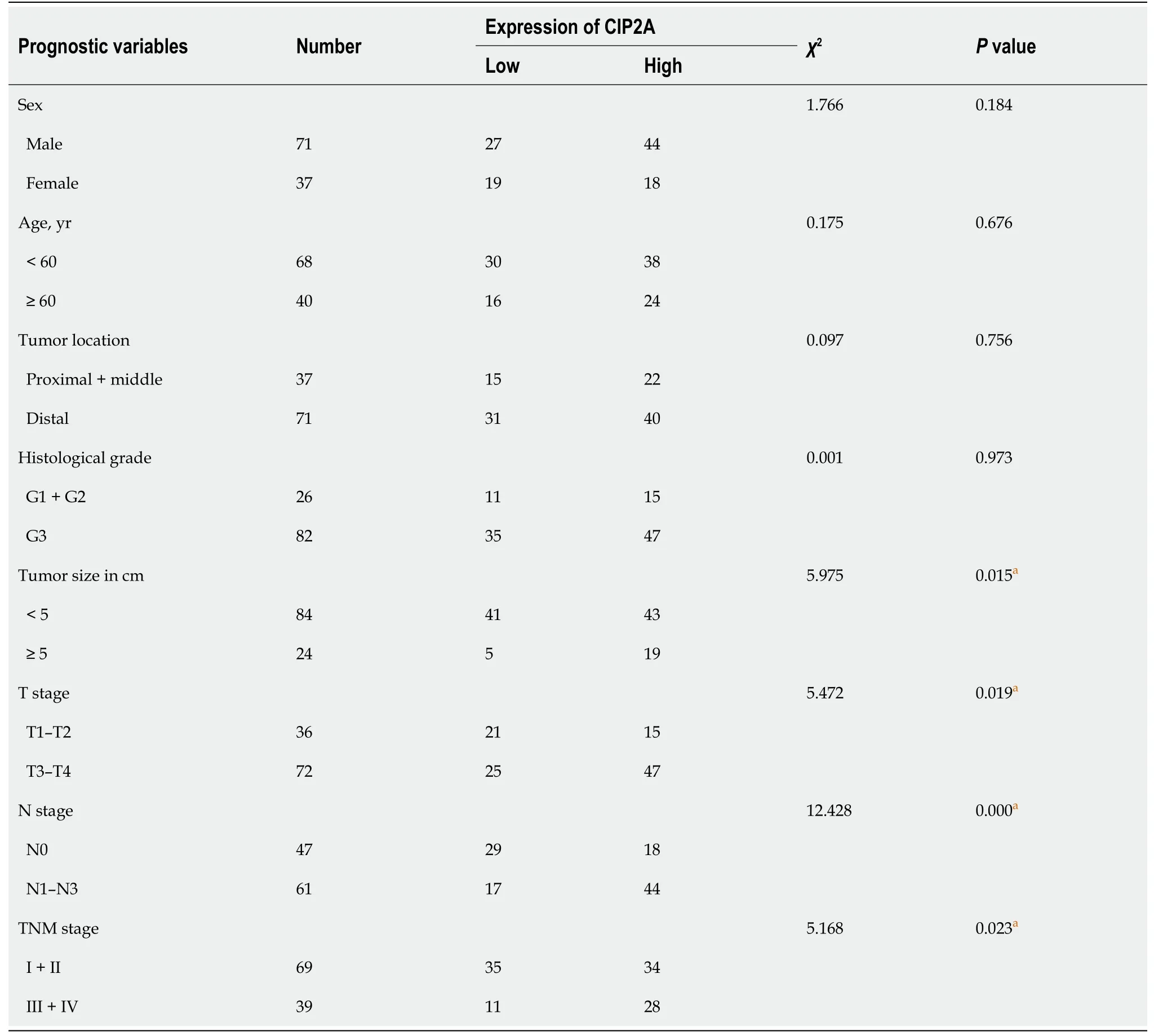
Table 1 Association between the expression of cancerous inhibitor of protein phosphatase 2A and clinicopathological features in patients with gastric cancer
Immunohistochemistry analysis
The expression of CIP2A in 108 pairs of GC tissue and matched adjacent normal tissue samples was evaluatedviaimmunohistochemistry (IHC) using the SP method. Formaldehyde-fixed and paraffinembedded 4-μm-thick samples were deparaffinized with xylene and rehydrated with graded ethanol. Antigen retrieval was performed by boiling in a pressure cooker. The endogenous peroxidase activity was blocked with H2O2. Primary antibodies (CIP2A antibody 1:500, Santa Cruz Biotechnology, United States) were added to the sections and incubated for 1 h at 37 °C in the dark. The secondary antibodies were then added at 37 °C for 30 min. Next, DAB (3,3′-Diaminobenzidine) chromogenic reagent was added to develop, and hematoxylin was added for staining. In the negative control group, phosphatebuffered solution (PBS) was used instead of the primary antibody. The IHC score of each slide was calculated by multiplying the intensity of staining by the average percentage of positive cells[27]. The staining intensity scores were classified as follows: colorless (no staining), 0; light yellow (weak staining), 1; yellow-brown (moderate staining), 2; and brown (strong staining), 3. The average percentages of positive cells were as follows: 1 = 1%-25%, 2 = 26%-50%, 3 = 51%-75%, and 4 = 76%-100%. Based on the Statistical Package for Social Sciences software version 20.0, the optimal cutoff IHC score was set as 6. In the final analysis, samples with a score of ≥ 6 were classified as CIP2Ahighexpression, whereas those with a score of < 6 were classified as CIP2Alowexpression.
Bioinformatics analysis
The Cancer Genome Atlas (TCGA) and The National Center for Biotechnology Information Gene Expression Omnibus (http://www.ncbi.nlm.nih.gov/geo/) were used to obtain data onCIP2AmRNA expression. Moreover, R software and the Bioconductor project were used to analyze and process data onCIP2AmRNA expression. Data on the mRNA expression ofCIP2Awere processed with log2 and standardized with R software. For the survival analysis ofCIP2A, the online tool Kaplan-Meier plotter (http://www.kmplot.com/gastric) was used to assess the prognostic value ofCIP2Ain GC patients. The Kaplan-Meier plotter database contains 875 patients with clinicopathologic information about GC from the National Center for Biotechnology Information Gene Expression Omnibus 208853 dataset. Moreover, the survival data were analyzed online. The Kaplan-Meier survival curves were drawn using GraphPad (GraphPad Prism 6.0, La Jolla, CA, United States).
Cell culture, reagents, and small interference RNA
Human GC cell lines MKN-45 and AGS, as well as normal human gastric epithelial cells (GES-1) (Chinese Academy of Sciences, China), were cultured in RPMI-1640 (Hyclone Laboratories Inc., United States) supplemented with 1% penicillin and streptomycin (North China Pharmaceutical Company, Inc., China) and 10% fetal bovine serum (Hyclone Laboratories Inc., United States). Oxaliplatin was purchased from the Hengrui Medicine Co., Ltd. (Jiangsu, China). Further, Invitrogen Inc. (Carlsbad, CA, United States) provided the uniqueCIP2Asmall interfering RNA (siRNA) and negative control. TheCIP2AsiRNA sequence is 5’-GACAACUGUCAAGUGUACCACUCUU-3’[28]. To deliver the siRNA into the MKN-45 and AGS cells, LipofectamineTM2000 (Invitrogen Inc., Carlsbad, CA, United States) was used based on the manufacturer’s instructions. In addition, MK-2206 was acquired from Cell Signaling Inc. (InvivoGen, San Diego, CA, United States).
3-(4,5-dimethylthiazol-2-yl)-2,5-diphenyltetrazolium bromide tetrazolium assay
Cell proliferation was detected using the 3-(4,5-dimethylthiazol-2-yl)-2,5-diphenyltetrazolium bromide tetrazolium (MTT) assay. Cultured cells were separated in 96-well plates for 12 h (5000 cells/well). Moreover, 20 μL/well of the MTT reagent was added to each sample after treatment. The sample was then incubated at 37 °C for 4 h before being washed with PBS. Following that, 200 μL of dimethyl sulfoxide was added. The 490-nm optical density was evaluated. The rate of cell proliferation was calculated as the score of surviving cells. Cell viability was measured as a percentage of survival (control group: 100%).
Real-time quantitative reverse transcription PCR
Total RNA was extracted in an RNase-free environment using TRIzol reagent (Invitrogen, United States), and cDNA was obtained using PrimeScript? RT Master Mix (Takara Biotechnology Co., China) according to the manufacturer’s instructions. Real-time quantitative reverse transcription (RT-q) PCR was performed using the 7500 Fast PCR System (Applied Biosystems, CA, United States) with SYBR? Premix Ex Taq? II (Takara Biotechnology Co., China). The reactions were carried out using the 20-μL reaction systemperthe manufacturer’s instructions. Moreover, glyceraldehyde-3-phosphate dehydrogenase was used as the housekeeping gene. The primer sequences were as follows:CIP2A(accession no. NM020890) sense 5’-GGCACTTGGAGGTAATTTCT-3’, anti-sense 5’-CTGGTTTCAATGTCTACTGCTAG-3’, glyceraldehyde-3-phosphate dehydrogenase (accession no. NM002046) sense 5’-AAGGCTGGGGCTCATTTG-3’, and anti-sense 5’-AGGAGGCATTGCTGATGATC-3’. All primers were provided by Takara Biotechnology Co. The expression of the reference gene glyceraldehyde-3-phosphate dehydrogenase was used to normalize the mRNA expression.
Immunoblotting assay
PBS and radio immunoprecipitation assay lysis buffer (Beyotime Biotechnology, China) was used to treat the cells, which were supplemented with 1 mmol/L phenylmethanesulfonyl fluoride. They were centrifuged for 15 min at 12000 × g at 4 °C. The supernatant was then collected, and the protein concentration was determined using the BCA protein assay (Beyotime Biotechnology, China). Using 10% sodium dodecyl sulfate-polyacrylamide gel electrophoresis, an equal amount of sample (50 μg) was isolated and moved into the polyvinylidene fluoride membrane. The samples were then blocked with 5% nonfat milk and incubated with the following primary antibodies: CIP2A (2G10-3B5, Santa Cruz Biotechnology, United States), phospho-Akt (Ser473, Santa Cruz Biotechnology, United States), Akt (Cell Signaling Technology, Inc., United States), and β-actin (Zhongshan Golden Bridge Biotech, China). βactin was used as an internal control. After that, samples were incubated with secondary antibodies (Zhongshan Golden Bridge Biotech, China) (1:5000). The SuperSignal West Pico Chemiluminescent Substrate (Thermo Fisher Scientific Inc., United States) was used to obtain the results. Moreover, data were analyzed using Quantity One (Bio-Rad Inc.).
Annexin V assay of apoptosis
After 48 h of siRNA treatment, the GC cells were treated with a specific dose of oxaliplatin (2 μg/mL) for 24 h. They were then collected, washed with PBS, and suspended with propidium iodide annexin Vfluorescein 5-isothiocyanate (BD Pharmingen, United States) in the binding buffer of annexin V. Fluorescence was detected using a flow cytometer (BD Biosciences, San Jose, CA, United States) after 20 min in the dark at room temperature. The cells were then counted using Flow Cytometry Cell Quest, and data were analyzed using Magnetic Cell Sorting Quant.
Statistical analysis
All examinations were performed in triplicate, and the results were presented as mean ± standard deviation. To compare absorbance values and percentages of apoptotic and viable cells, the two-tailed Student’sttest was used. The Pearson’sχ2test was used to examine the relationship between CIP2A and clinicopathological features. Moreover, survival analysis was conducted using the Kaplan-Meier method, and the difference in survival curves was examined using the log-rank test. We also ran univariate and multivariate Cox proportional hazards regression analyses. All statistical analyses were performed using GraphPad Prism 6.0 and the Statistical Package for the Social Sciences software version 20.0 (IBM, Armonk, United States). SigmaPlot 10.0 (Systat Software Inc., United States) was utilized to display the results. Further,Pvalues of < 0.05 (aP< 0.05,bP< 0.01,cP< 0.001) were considered significant.
RESULTS
High CIP2A expression in GC tissues and its correlation with clinicopathological features
To investigate the clinical value of CIP2A in GC, we assessed the expression of CIP2A in 108 pairs of GC tissue and matched normal tissue samples using IHC and hematoxylin and eosin staining (Figure 1A). CIP2A was found in the nucleus and, more specifically, the cytoplasm of GC cells (Figure 1A). CIP2A expression was found to be significantly higher in tumor tissues. Meanwhile, CIP2A expression was absent or significantly reduced in adjacent normal gastric tissues (Figure 1A). CIP2A expression in GC tissues was significantly higher than that in adjacent normal gastric tissues (Figure 1B). RT-qPCR and Western blot analysis were performed to detect the expression of CIP2A in 18 pairs of fresh GC tissue and adjacent normal gastric tissue samples. Results showed that the expression of CIP2A in GC tissues was significantly higher than that in adjacent normal gastric tissues (Figure 1C and D). This finding supported the IHC analysis results of paraffin-embedded tissues (Figure 1A). The mRNA expression ofCIP2Awas then assessed using The Cancer Genome Atlas data from paired (n= 27,P< 0.05, Figure 1E) and unpaired databases (n= 210, normal samples;n= 414, tumor samples,P< 0.05, Figure 1F). CIP2A expression was significantly higher in GC tissues than in adjacent normal gastric tissues (Figure 1).
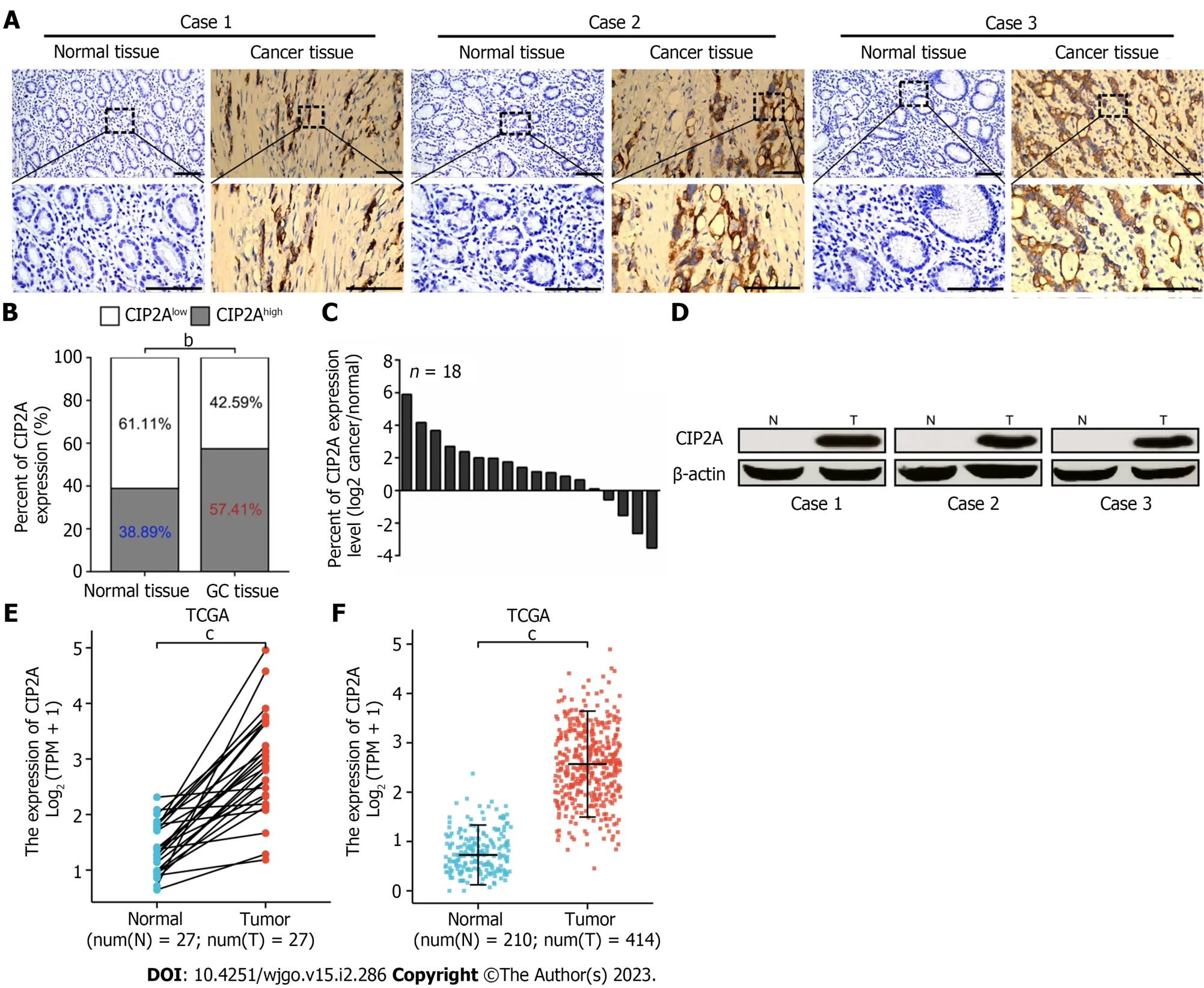
Figure 1 Cancerous inhibitor of protein phosphatase 2A was highly expressed in gastric cancer tissues. A: Representative immunohistochemistry images of cancerous inhibitor of protein phosphatase 2A (CIP2A) in the adjacent normal gastric tissues and gastric cancer (GC) tissues (scale bar = 50 μm); B: The percentage of CIP2Ahigh expression was significantly higher in GC tissues than in adjacent normal gastric tissues; C: The mRNA expression levels of CIP2A were higher in 18 fresh frozen GC tissues than in matched adjacent normal gastric tissues; D: Western blot analysis showed that CIP2A expression level in tumor tissues (T) was significantly higher than that in adjacent normal tissues (N). Representative images were displayed in paired fresh surgical GC tissues; E and F: Based on data in The Cancer Genome Atlas (TCGA), including paired sample data and unpaired sample data (F), GC tissues had a higher CIP2A expression than adjacent normal gastric tissues. bP < 0.01. cP < 0.001.
We further investigated the relationship between CIP2A expression and clinicopathological features in 108 patients with GC. As shown in Table 1, high CIP2A expression was associated with tumor size (P= 0.015), T stage (P= 0.019), N stage (P= 0.000), and Tumor Node Metastasis stage (P= 0.023) but not with sex (P= 0.184), age (P= 0.676), tumor location (P= 0.756), and histological grade (P= 0.973).
According to these findings, CIP2A expression was significantly higher in GC tissues. CIP2A could thus be an oncogene that promotes tumor development in GC.
Association between the overexpression of CIP2A and poor prognosis in patients with GC
We investigated the prognostic value of CIP2A expression in GC patients. In 108 GC patients followed up for a median of 58 mo (range: 3-74 mo), 61 (56.48%) died and 47 (43.52%) survived. According to the Kaplan-Meier survival analysis, patients with high CIP2A expression had a shorter overall survival (hazard ratio: = 1.814, 95% confidence interval = 1.038-3.032,P= 0.0375, Figure 2A) and progression-free survival (hazard ratio = 1.805, 95% confidence interval = 1.039-3.043,P= 0.0383, Figure 2B) than those with low CIP2A expression. Based on the National Center for Biotechnology Information Gene Expression Omnibus 208853 dataset, a similar trend was discovered, confirming the prognostic significance ofCIP2Aexpression in patients with GC (Figure 2C and D).
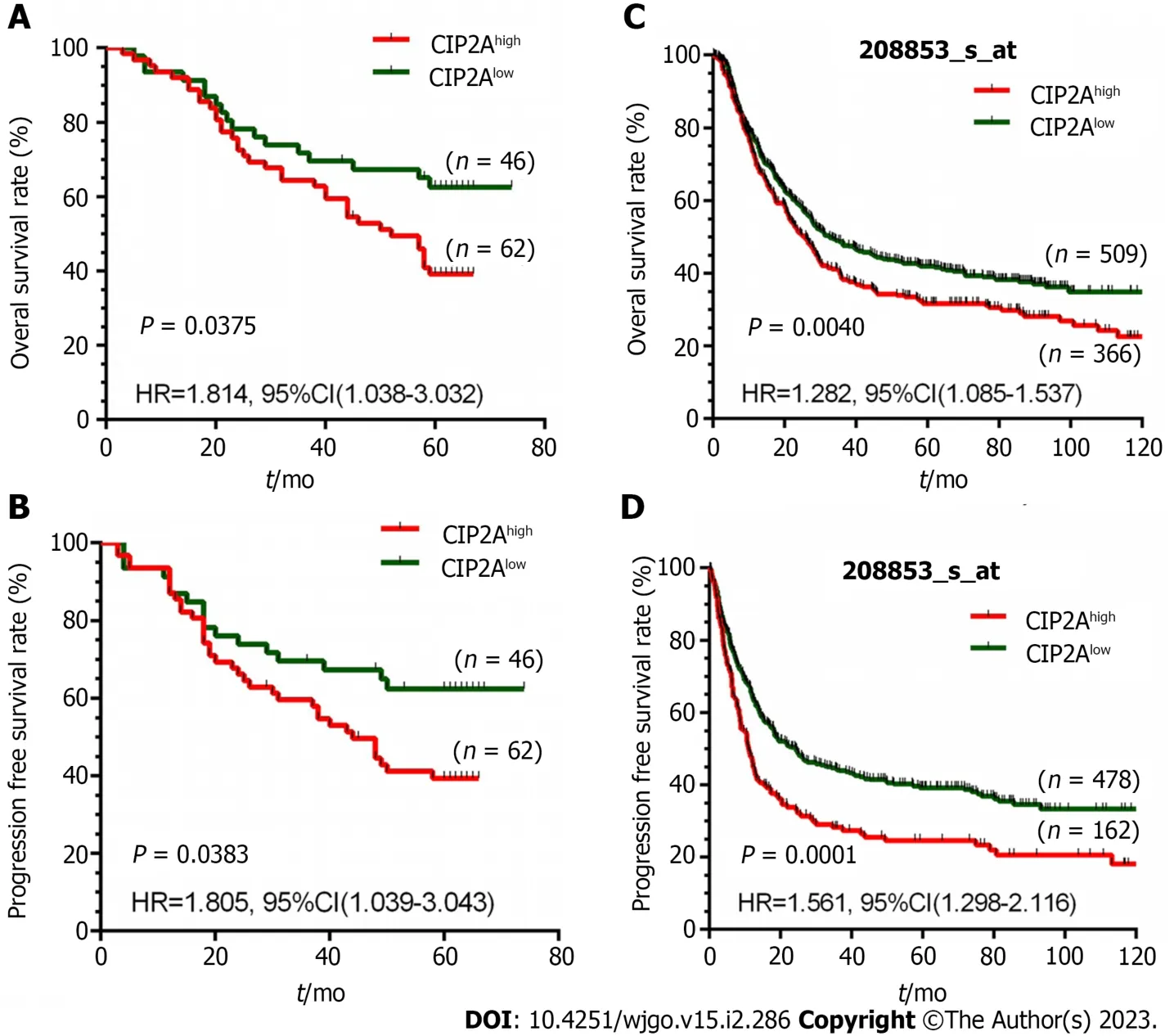
Figure 2 High expression of cancerous inhibitor of protein phosphatase 2A was associated with poor overall survival rate and progression-free survival rate in patients with gastric cancer. A: Based on the Kaplan-Meier analysis, a high cancerous inhibitor of protein phosphatase 2A (CIP2A) expression was associated with overall survival (P = 0.0375) in 108 patients with gastric cancer; B: Based on the Kaplan-Meier analysis, a high CIP2A expression was associated with progression-free survival (P = 0.0383) in 108 patients with gastric cancer; C and D: According to the Kaplan-Meier analysis of data on gastric cancer from the 208853_s_at dataset, patients with CIP2Ahigh expression tumors had a significantly lower overall survival rate (P = 0.0040) (C) and progression-free survival rate (P < 0.0001) (D) than those with CIP2Alow expression tumors. CI: Confidence interval; HR: Hazard ratio.
The Cox proportional risk regression model was used to evaluate CIP2A expression and the prognostic factors in GC patients. Univariate analysis showed that tumor size, T stage, N stage, Tumor Node Metastasis stage, and CIP2A expression (Tables 2 and 3) were significantly correlated with prognosis in patients with GC. According to the multivariate analysis, a significant increase in CIP2A expression was associated with lower overall survival and progression-free survival rates in patients with GC. Further, the expression of CIP2A was an independent prognostic factor in patients with GC (P= 0.046 and 0.042, Tables 2 and 3). As a result, CIP2A could be an important oncoprotein in the development of GC.
High expression of CIP2A in human GC cell lines
CIP2A has been shown to promote the proliferation of the human GC cell lines AGS and MKN-45. However, its molecular mechanism remains unknown. To determine the expression of CIP2A in AGS, MKN-45, and GES-1, RT-qPCR and immunoblotting were performed. The mRNA expression ofCIP2Ain human GC cell lines AGS and MKN-45 was higher than in the human GC cell line GES-1 (Figure 3A). According to the protein expression analysis, CIP2A expression was higher in the human GC cell lines AGS and MKN-45 (Figure 3B and C). Due to their high expression of CIP2A, AGS and MKN-45 were selected.
Proliferation of human GC cells decreased after knockdown of CIP2A
To assess the role of CIP2A in the growth of human GC cell lines, siRNA targeting CIP2A was transfected into AGS and MKN-45. RT-qPCR revealed that the mRNA expression ofCIP2Aknockdown in MKN-45 cells was 90% lower than that of scrambled siRNA and mock cells (P< 0.01). Meanwhile, the mRNA expression ofCIP2Aknockdown in AGS cells was 88% lower than that of scrambled siRNA and mock cells (P< 0.01). There was no statistically significant difference between the last two samples (Figure 4A and B). These findings were confirmed by immunoblotting (Figure 4C-F). Based on the MTT assay, the downregulation of CIP2A expression significantly reduced the proliferation of AGS and MKN-45 cells. When compared to scrambled siRNA and mock cells, CIP2A siRNA significantly reduced the rate of AGS and MKN-45 cell proliferation (P< 0.05) (Figure 4G and H).
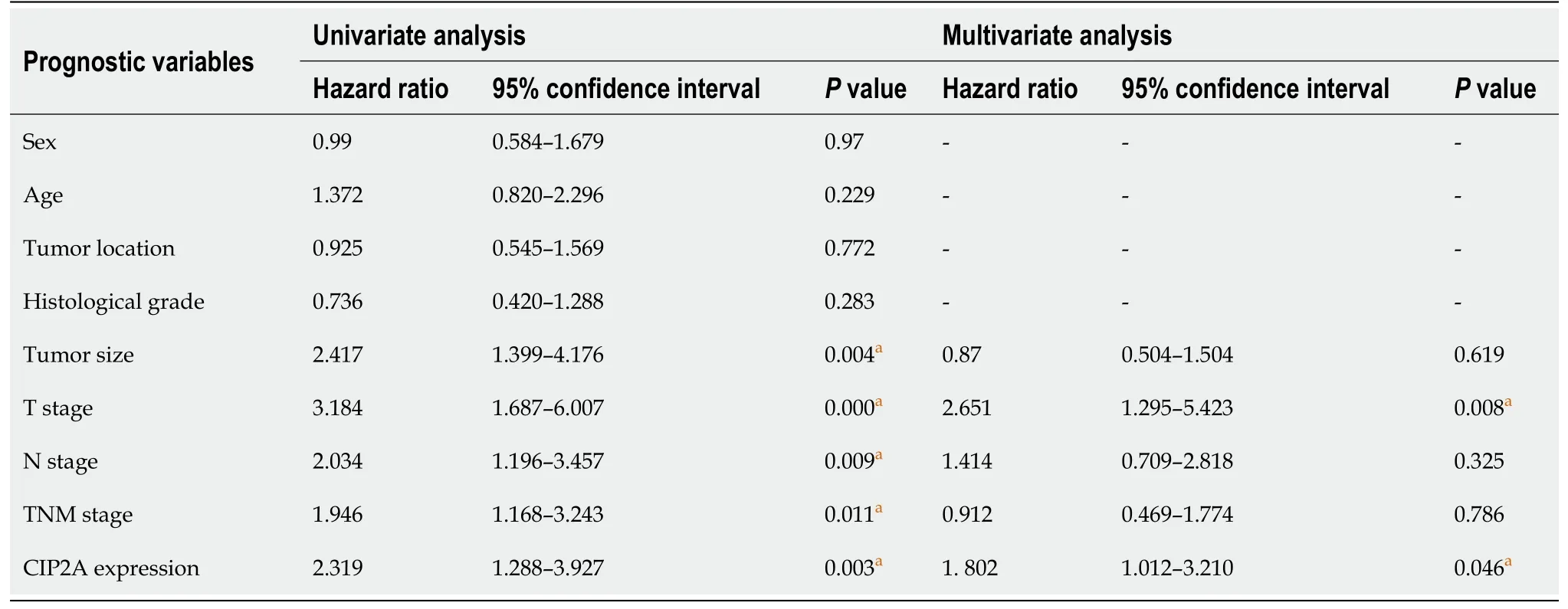
Table 2 Univariate and multivariate analyses of overall survival in patients with gastric cancer
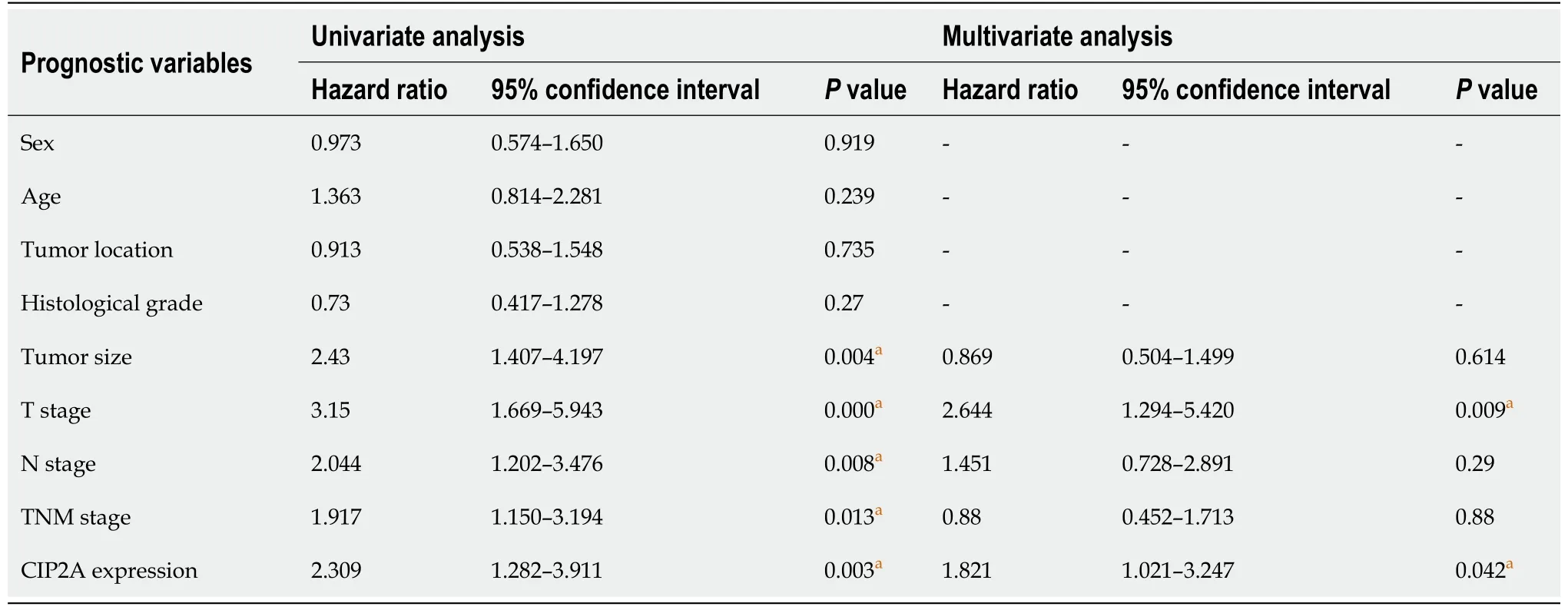
Table 3 Univariate and multivariate analyses of progression-free survival in patients with gastric cancer
Increased sensitivity to oxaliplatin in human GC cells induced by the knockdown of CIP2A
CIP2A may be overexpressed in human GC cells. Thus, there could be a correlation between CIP2A expression and oxaliplatin sensitivity. To test this theory, CIP2A knockdown cells were treated with oxaliplatin at various concentrations. CIP2A knockdown increased susceptibility to oxaliplatin significantly (Figure 5A and B). The half maximal inhibitory concentrations of oxaliplatin in CIP2Adownregulated MKN-45 and AGS cells were 2.9 μg/mL and 3.6 μg/mL, respectively. In the control sample, the concentrations were 5.3 μg/mL and 6.2 μg/mL, respectively (P< 0.05). The susceptibility of MKN-45 and AGS cells to oxaliplatin were strengthened by 45% and 42%, respectively. Thus, cells with downregulated CIP2A expression were more sensitive to oxaliplatin treatment.
Oxaliplatin-induced apoptosis in human GC cells induced by the knockdown of CIP2A
Flow cytometric analysis was used to determine whether CIP2A knockdown promoted cell apoptosis. Following oxaliplatin treatment, propidium iodide and annexin V staining were performed. Interestingly, CIP2A knockdown significantly enhanced apoptosis caused by oxaliplatin (2 μg/mL). The apoptosis rates of CIP2A-downregulated MKN-45 and AGS cells added to oxaliplatin exhibited 33.5% and 23.6%, respectively. Control rates in oxaliplatin-treated cells were 16.3% and 11.6%, respectively (P< 0.05). In addition, siRNA transfection of CIP2A did not increase the apoptosis rate (Figure 6A-C). As a result, CIP2A knockdown caused cell apoptosis. Hence, high CIP2A expression could be a factor of oxaliplatin resistance in GC cells.
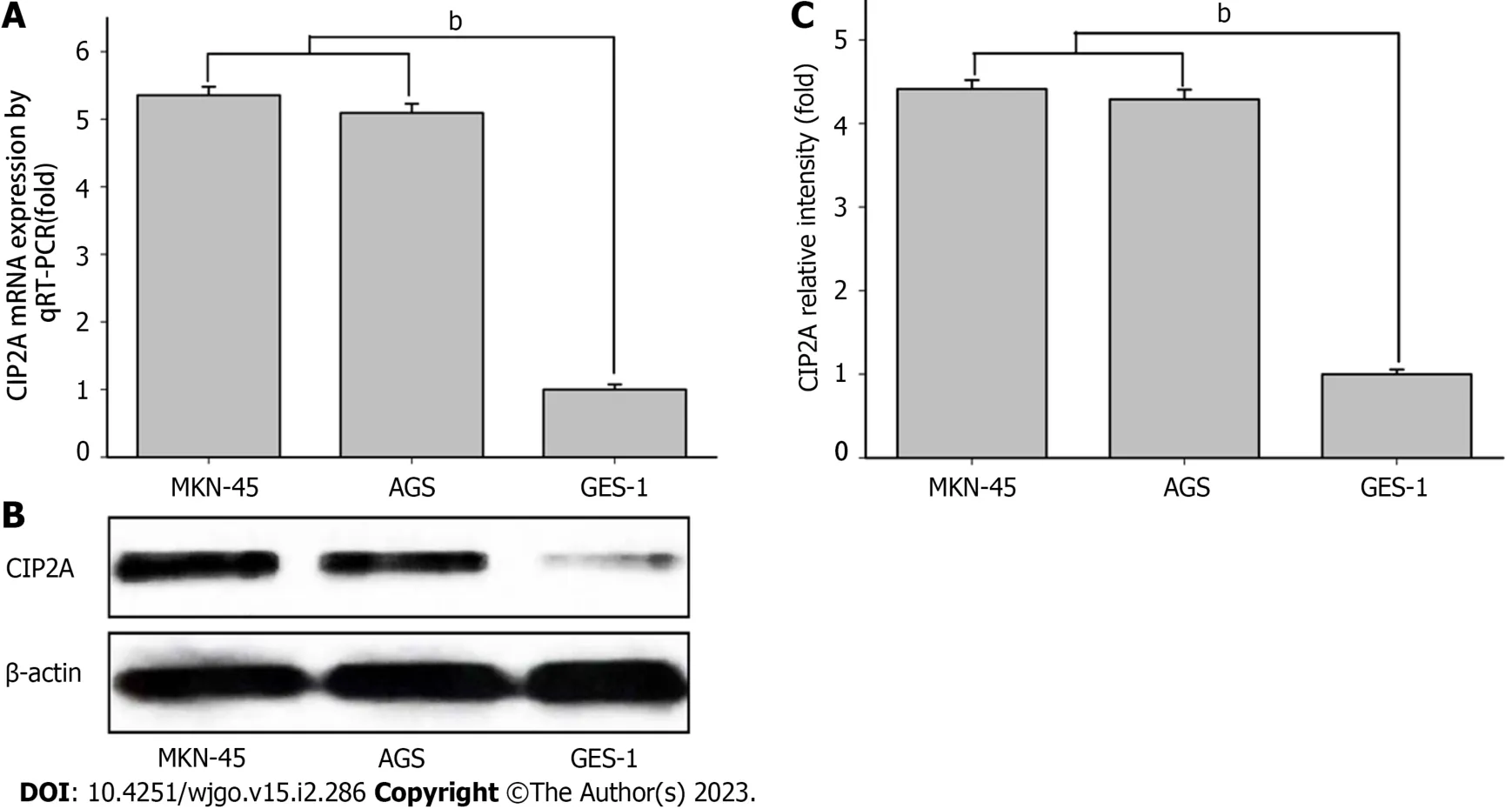
Figure 3 Expression of cancerous inhibitor of protein phosphatase 2A in human gastric cancer cells. A: The mRNA expression of cancerous inhibitor of protein phosphatase 2A (CIP2A) in human gastric cancer cell lines (MKN-45 and AGS) and normal gastric epithelial cells (GES-1); B: The expression of cancerous inhibitor of protein phosphatase 2A was examined via immunoblotting; C: Immunoblotting was quantified using a spectrophotometer. The results consisted of three independent tests. Gastric cancer cell lines vs GES-1. bP < 0.01. RT: Reverse transcription.
Akt phosphorylation of human GC cells regulated by CIP2A
To validate the potential mechanisms by which CIP2A promoted the chemoresistance of human GC cells, the protein expression and phosphorylation level of Akt signaling in CIP2A knockdown AGS and MKN-45 cells were evaluated. According to the findings, CIP2A knockdown significantly reduced Akt phosphorylation levels (Ser473). However, it had no effect on the level of Akt protein expression (Figure 7A-C). Based on these findings, CIP2A influenced Akt activity in human GC cells, and CIP2A knockdown decreased cell proliferation and increased sensitivity to oxaliplatin in human GC cells by decreasing the Akt activity.
Increased sensitivity to oxaliplatin in human GC cells caused by chemical inhibition of Akt signaling
Moreover, to validate the effects of Akt signaling in CIP2A with respect to sensitivity to oxaliplatin, MK-2206, an allosteric Akt inhibitor, was used to pretreat the high expression CIP2A human GC cell line. The expression of the indicated proteins and sensitivity to oxaliplatin were assessed using immunoblotting and the MTT assay, respectively. Pretreatment with MK-2206 reduced p-Akt levels (Figure 8A and B) while increasing sensitivity to oxaliplatin (Figure 8C and D) in MKN-45 and AGS cells. Thus, Akt signaling may play a role in sensitizing CIP2A overexpression in human GC cells exposed to oxaliplatin.
DISCUSSION
When first diagnosed, most patients have middle- and late-stage GC. The only curative treatment option for gastric tumors is surgical resection. However, patients frequently relapse after resection. Therefore, after 1B resection, combination therapy has become the standard treatment for advanced-stage disease[29]. As the first-line chemotherapy regimen, a platinum-fluoropyrimidine-based treatment is often used[30]. Oxaliplatin, as the third-generation platinum derivative, has been used successfully to treat GC[31,32]. According to the CLASSIC trial, XELOX (capecitabine and oxaliplatin) is superior to observation alone after D2 radical gastrectomy. Hence, chemotherapy is effective[33]. Although patients initially respond well to oxaliplatin, they eventually develop resistance[34,35]. Tumor cells can gain resistance to the cytotoxic effects of oxaliplatin, similar to other anticancer drugs[36]. However, its specific molecular mechanism remains unknown, and it must be investigated further.
CIP2A promotes cell proliferation and tumorigenesis in numerous types of tumors by maintaining c-Myc[18,22,37]. In addition, CIP2A overexpression is correlated with a poor prognosis[21,37]. Interestingly, recent studies on breast, colon, and lung cancer cells have revealed that overexpression of CIP2A may induce chemoresistance in cancer cells[24,25]. The current study sought to determine the association between CIP2A expression and oxaliplatin sensitivity.
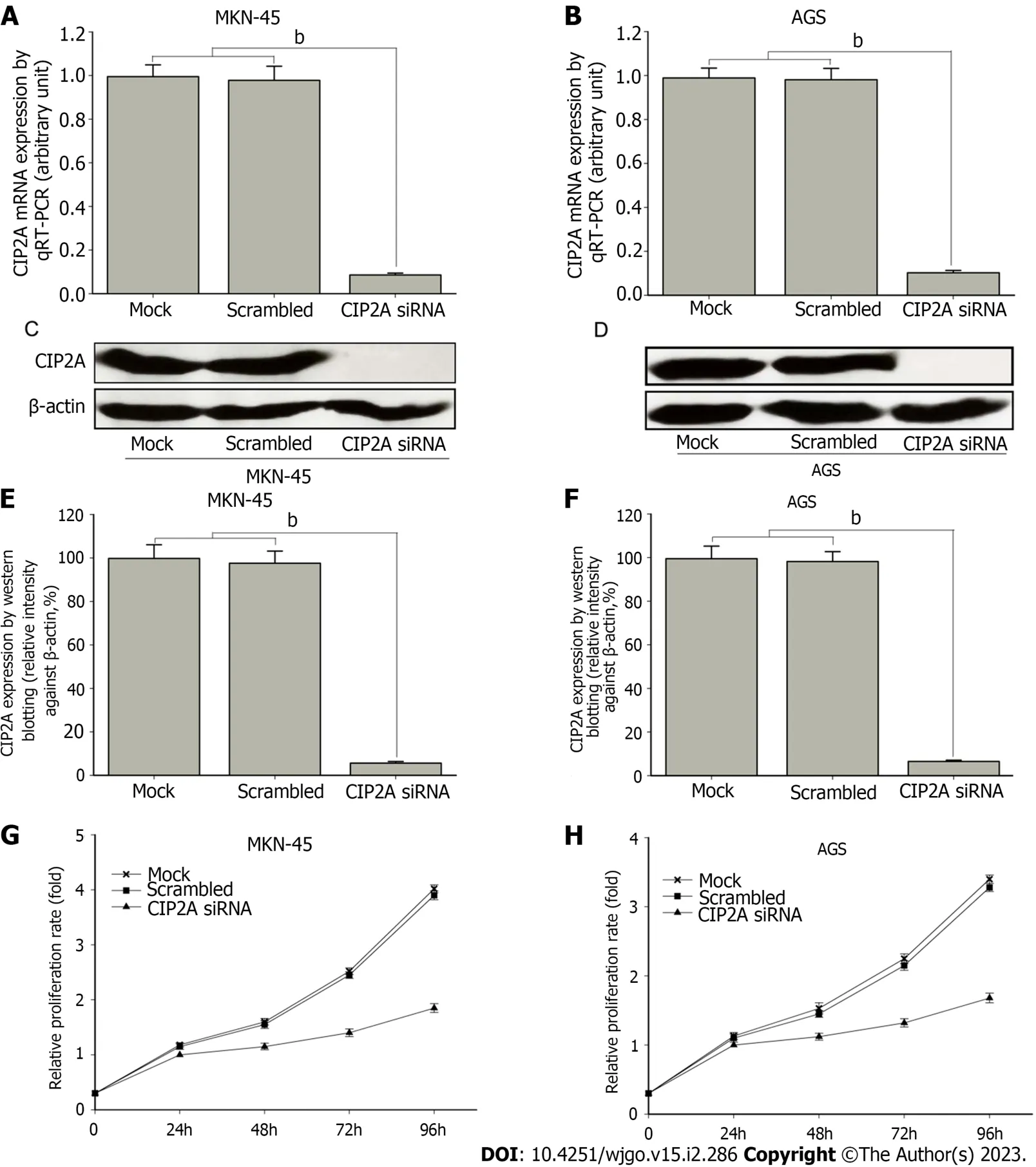
Figure 4 Small interference RNA targeting cancerous inhibitor of protein phosphatase 2A effectively downregulated expression and decreased cell proliferation in human gastric cancer cells. MKN-45 and AGS cells were transfected with negative control small interference RNA (siRNA) or cancerous inhibitor of protein phosphatase 2A (CIP2A) siRNA for 48 h. A: CIP2A expression in MKN-45 cells was determined via real-time quantitative reverse transcription (RT) PCR; B: CIP2A expression in AGS cells was determined via real-time quantitative RT PCR; C and D: CIP2A expression was determined via immunoblotting; E and F: Data were quantified using a spectrophotometer. The CIP2A siRNA group vs the control siRNA group. G and H: The downregulation of CIP2A expression could decrease cell proliferation in MKN-45 and AGS cells based on the 3-(4,5-dimethylthiazol-2-yl)-2,5-diphenyltetrazolium bromide tetrazolium assay. Data showed a significant reduction in the proliferation of CIP2A siRNA-treated cells. The results were three independent tests. bP < 0.01.
Using The Cancer Genome Atlas data analysis, we discovered that the expression ofCIP2Ain GC tissues was significantly higher than that in adjacent normal gastric tissues. We also confirmed consistent results in GC tissue specimens. Survival analysis revealed thatCIP2Aexpression was significantly correlated with overall survival and progression-free survival in patients with GC. Moreover, CIP2A expression in GC cells was significantly higher compared to GES-1 cells. CIP2A overexpression has previously been observed in several GC cells[38], and this finding is similar to the current study. As a result, MKN-45 and AGS were studied further because they have high CIP2A expression[18,39-41].
We performed siRNA knockdown of CIP2A expression to investigate its biological function in GC cells. Results showed that CIP2A silencing reduced the growth rate of MKN-45 and AGS cells, indicating that CIP2A plays an important role in GC cell proliferation. A similar finding has been reported in our previous studies[42]. To investigate the association between CIP2A expression and drug sensitivity, we knocked down CIP2A in GC cells and tested their sensitivity to oxaliplatin treatment. Previous studies have shown that the knockdown of CIP2A significantly increased the susceptibility of GC cells to oxaliplatin. Based on some reports, CIP2A can promote the proliferation of colon cancer cells, and CIP2A knockdown significantly increased sensitivity to oxaliplatin in colon cancer cells[43,44]. As a result, GC cells with CIP2A expression downregulation were more sensitive to oxaliplatin treatment.

Figure 5 Downregulation of cancerous inhibitor of protein phosphatase 2A significantly increased sensitivity to oxaliplatin in human gastric cancer cells. A: MKN-45 cells were transfected with cancerous inhibitor of protein phosphatase 2A (CIP2A) small interfering RNA (siRNA) for 48 h and were added with oxaliplatin at different concentrations for 24 h; B: AGS cells were transfected with cancerous inhibitor of protein phosphatase 2A siRNA for 48 h and were added with oxaliplatin at different concentrations for 24 h. The cell viability was examined using the 3-(4,5-dimethylthiazol-2-yl)-2,5-diphenyltetrazolium bromide tetrazolium assay. The results consisted of three independent tests. The siRNA group vs the control siRNA group. bP < 0.01.
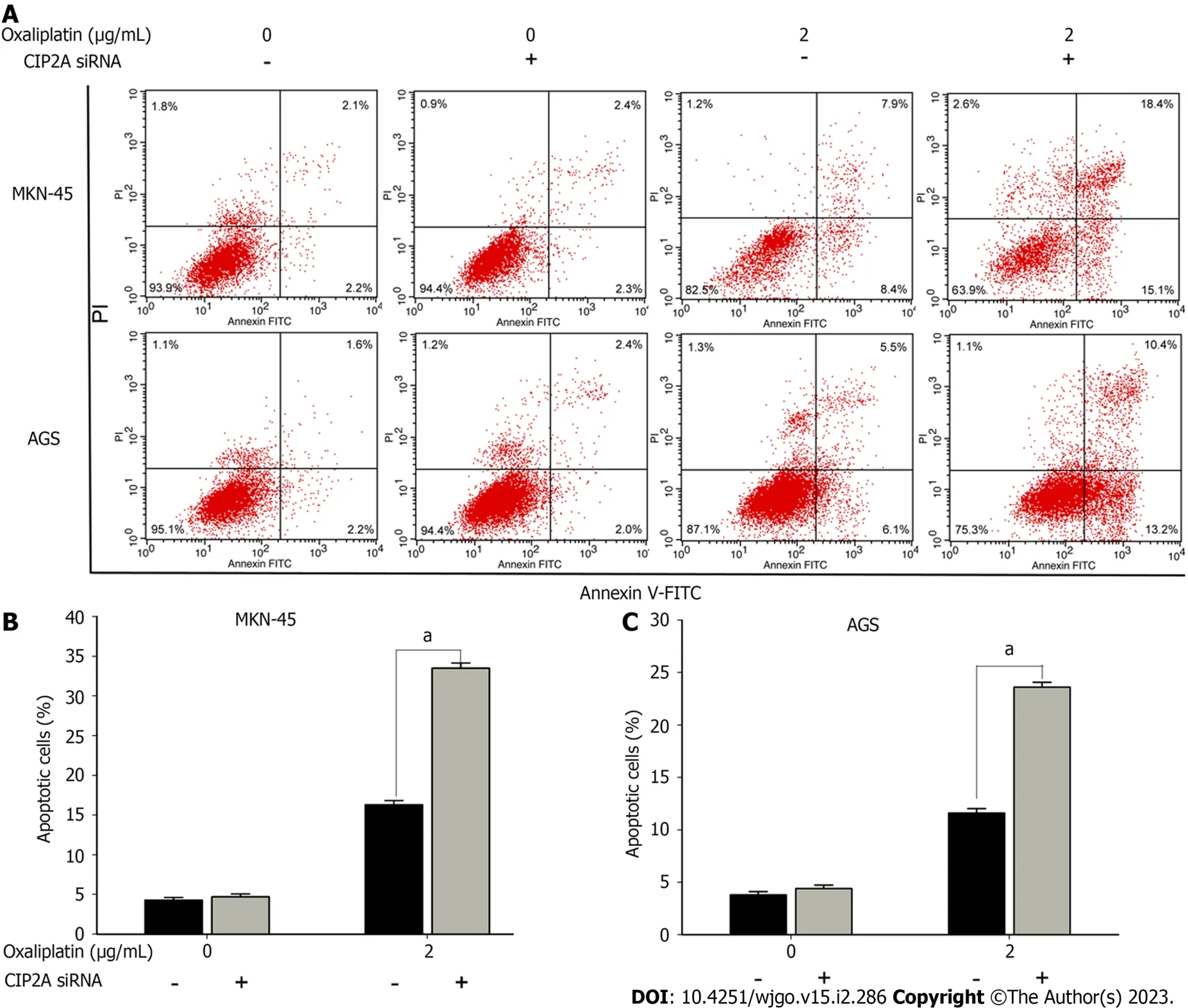
Figure 6 Downregulation of cancerous inhibitor of protein phosphatase 2A promoted oxaliplatin-related apoptosis in human gastric cancer cells. Control small interference RNA (siRNA) and cancerous inhibitor of protein phosphatase 2A (CIP2A) siRNA-transfected human gastric cancer cells were exposed to oxaliplatin (2 μg/mL). A: At 24 h after treatment, apoptosis was examined via annexin V/propidium iodide staining and flow cytometry; B and C: The percentage of apoptotic cells was quantitatively presented in MKN-45 (B) and AGS (C) cells. The results consisted of three independent tests. The cancerous inhibitor of protein phosphatase 2A siRNA group vs the control siRNA group. aP < 0.05. V-FITC: V-fluorescein 5-isothiocyanate.
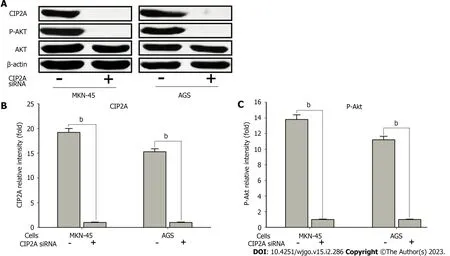
Figure 7 Cancerous inhibitor of protein phosphatase 2A affected protein kinase B phosphorylation in human gastric cancer cells. MKN-45 and AGS cells were transfected with the control small interfering RNA (siRNA) or cancerous inhibitor of protein phosphatase 2A (CIP2A) siRNA for 48 h. A: Immunoblotting was used to analyze the indicated protein expression; B and C: The CIP2A (B) and phosphorylated protein kinase B (p-Akt) (C) protein levels were quantified using a spectrophotometer. The results consisted of three independent tests. bP < 0.01. Akt: Protein kinase B.
Oxaliplatin has the ability to cause apoptosis in GC cells[45,46]. Nevertheless, the underlying mechanism is unknown. Previous studies have shown that CIP2A plays an important role in lung cancer cell apoptosis when treated with cisplatin[47]. The biological impact of CIP2A is a common phenomenon in tumor cells. According to a recent study, the downregulation of CIP2A expression in MKN-45 and AGS cells increased apoptosis and oxaliplatin sensitivity, which could be a cause of oxaliplatin resistance in GC. Therefore, CIP2A knockdown made GC cells more susceptible to oxaliplatin-induced apoptosis, enhancing the cytotoxic effect of oxaliplatin.
According to a previous study, inhibiting the Akt pathway sensitizes GC cells to apoptosis caused by cisplatin[48]. Therefore, we discovered that signaling was correlated with the biological behaviors of CIP2A. Since the phosphorylation of Akt is a critical step in phosphoinositide 3-kinase/Akt signaling activation[49], we confirmed its association with CIP2A expression. CIP2A knockdown caused the phosphorylation of Akt in both MKN-45 and AGS cells, according to the findings. Moreover, the chemical inhibition of the Akt signaling pathway increased oxaliplatin sensitivity in human GC cells. Several studies have found that the downregulation of CIP2A expression can improve the efficacy of chemotherapeutic drugs and inhibit Akt signaling in colorectal and lung cancers[26,38]. As a result, the association between CIP2A and the Akt signaling pathway might be involved in the biological functions of GC cells. This interaction could be correlated with oxaliplatin resistance in GC.
CONCLUSION
A high expression of CIP2A can promote chemoresistance to oxaliplatin in GC, and Akt signaling may play a role in this mechanism. The inhibition of CIP2A significantly improved sensitivity to oxaliplatin in human GC cells. As a result, suppressing CIP2A expression may be an indirect strategy for more effectively treating patients with GC. Nevertheless, further clinical trials on the role of this signaling pathway should be conducted.
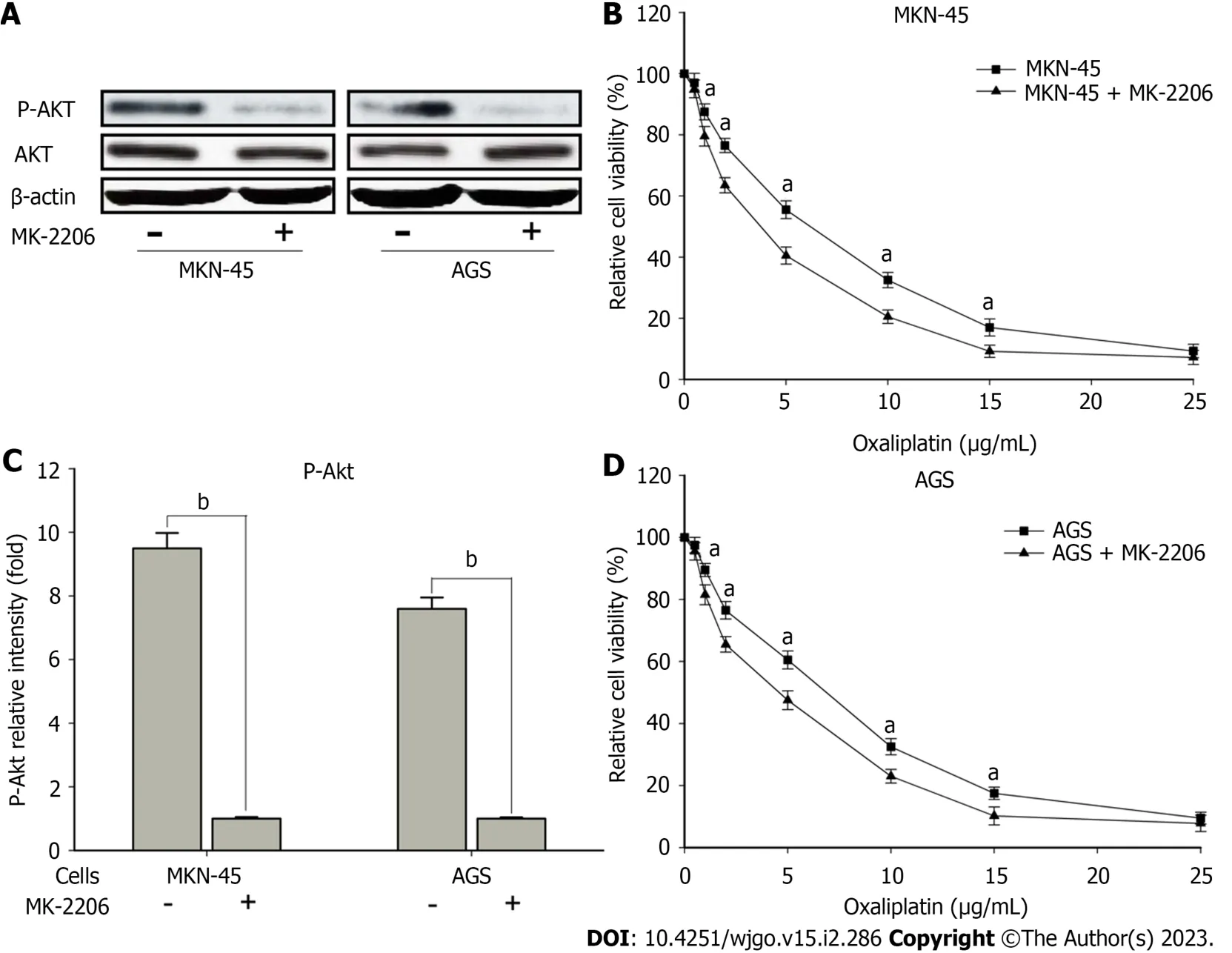
Figure 8 Chemical inhibition of protein kinase B signaling significantly increased sensitivity to oxaliplatin in human gastric cancer cells. MKN-45 and AGS cells were added to inhibitor of protein kinase B (MK-2206; 20 μM) for 2 h. A: Immunoblotting was performed to evaluate the corresponding protein expression; B: The phosphorylated protein kinase B (P-Akt) protein levels were quantified via densitometry; C and D: The pretreated cells were exposed to oxaliplatin at different concentrations for 24 h, and the viability was examined using the 3-(4,5-dimethylthiazol-2-yl)-2,5-diphenyltetrazolium bromide tetrazolium assay. The results consisted of three independent tests. The MK-2206-treated group vs the control group. aP < 0.05. bP < 0.01. Akt: Protein kinase B.
ARTICLE HIGHLIGHTS
Research background
Cancerous inhibitor of protein phosphatase 2A (CIP2A) plays a key role in various types of tumors, which may be related to the resistance of gastric cancer (GC) cells to oxaliplatin.
Research motivation
The mechanism of drug resistance in gastric cancer needs to be further studied, and CIP2A expression in GC cells and the mechanism of oxaliplatin resistance may be a breakthrough.
Research objectives
To explore the expression of the CIP2A in human GC cells and its correlation with oxaliplatin resistance.
Research methods
Immunohistochemistry was used to examine CIP2A expression in GC tissues and adjacent normal tissues.CIP2Agene expression in GC cell lines was reduced using small interfering RNA. After confirming the silencing efficiency, 3-(4,5-dimethylthiazol-2-yl)-2,5-diphenyltetrazolium bromide tetrazolium and flow cytometry assays were used to evaluate cell proliferation and apoptosis, respectively, caused by oxaliplatin treatment. Further, the key genes and protein changes were verified using real-time quantitative reverse transcription PCR and Western blotting, respectively, before and after intervention. For bioinformatics analysis, we used the R software and Bioconductor project. For statistical analysis, we used GraphPad Prism 6.0 and the Statistical Package for the Social Sciences software version 20.0.
Research results
High CIP2A expression was associated with tumor size, T stage, lymph node metastasis, Tumor Node Metastasis stage, and poor prognosis. CIP2A knockdown inhibited cell proliferation and significantly increased the susceptibility of GC cells to oxaliplatin. CIP2A regulated the phosphorylation of protein kinase B, and chemical inhibition of the protein kinase B signaling pathway was significantly associated with increased sensitivity to oxaliplatin.
Research conclusions
CIP2A expression was closely related to chemotherapy resistance of GC cells. The protein kinase B signaling pathway was correlated with CIP2A-enhanced chemoresistance of human GC cells to oxaliplatin.
Research perspectives
Regulation of CIP2A expression may be one of the key points in the treatment of GC chemotherapy resistance.
ACKNOWLEDGEMENTS
The authors would like to express their gratitude to Doctor Lei Jiang (The Sixth Department of General Surgery, The First Hospital of Lanzhou University, Gansu, China) for the critical revision of this manuscript. The authors also greatly appreciate the experimental assistance provided by Doctor Yu-Ping Wang (The Department of Gastroenterology, The First Hospital of Lanzhou University, Gansu, China).
FOOTNOTES
Author contributions:Zhao YX, Yang Z, Dang JY, and Wang F performed the experiments and image acquisition; Zhao YX, Ze Yang, Ma LB, and Wang HY designed the study and wrote the manuscript; Zhao YX, Yang Z, and Ma LB edited the manuscript.
Supported byThis work was supported by the Natural Science Foundation of Gansu Province, China, No. 17JR5RA272 and No. 22JR5RA923; and the Research Fund Project of The First Hospital of Lanzhou University, No. ldyyyn2021-120, No. ldyyyn2020-98 and No. ldyyyn2021-30.
Institutional review board statement:The study was reviewed and approved by the Lanzhou University No.1 Hospital Institutional Review Board (Approval No. LDYYLL-2022-376).
Informed consent statement:All study participants, or their legal guardian, provided informed written consent prior to study enrollment.
Conflict-of-interest statement:The authors declare that they have no competing interests.
Data sharing statement:The datasets used and/or analyzed during this study are available from the corresponding author upon reasonable request.
Open-Access:This article is an open-access article that was selected by an in-house editor and fully peer-reviewed by external reviewers. It is distributed in accordance with the Creative Commons Attribution NonCommercial (CC BYNC 4.0) license, which permits others to distribute, remix, adapt, build upon this work non-commercially, and license their derivative works on different terms, provided the original work is properly cited and the use is noncommercial. See: https://creativecommons.org/Licenses/by-nc/4.0/
Country/Territory of origin:China
ORCID number:Yong-Xun Zhao 0000-0002-7728-1248; Ze Yang 0000-0003-4546-9753.
S-Editor:Liu GL
L-Editor:Filipodia
P-Editor:Cai YX
 World Journal of Gastrointestinal Oncology2023年2期
World Journal of Gastrointestinal Oncology2023年2期
- World Journal of Gastrointestinal Oncology的其它文章
- Comment on “Crosstalk between gut microbiota and COVID-19 impacts pancreatic cancer progression”
- Prognostic value of claudin 18.2 expression in gastric adenocarcinoma
- Potent bromodomain and extraterminal domain inhibitor JAB-8263 suppresses MYC expression and exerts anti-tumor activity in colorectal cancer models
- microRNA-627-5p inhibits colorectal cancer cell proliferation,migration and invasion by targeting Wnt2
- Increased CD4/CD8 Lymphocyte ratio predicts favourable neoadjuvant treatment response in gastric cancer: A prospective pilot study
- Evaluation of polygenic risk score for risk prediction of gastric cancer
